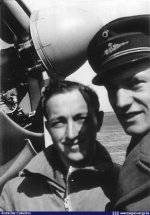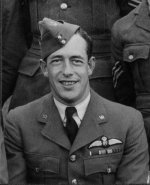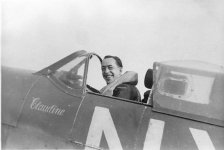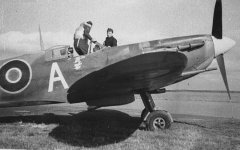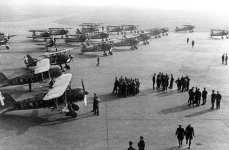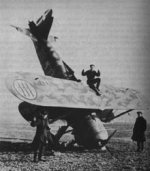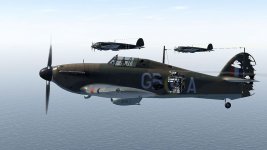BLReed
Sergeant Major
- Joined
- Nov 22, 2009
- Messages
- 1,676
American Pilots and the Battle of Britain
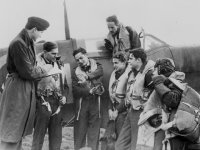
For the duration of the Battle of Britain, America was officially neutral, only coming into the war after the attack on Pearl Harbour in December 1941. Many in America supported what Great Britain and her allies were fighting for but memories of World War One were still raw and isolationism was a widely accepted practice within America. However, a few young men – for whatever personal reasons – wanted to offer more than just moral support. A few Americans arrived in Britain and offered to fight for Fighter Command. A ‘special arrangement’ with the RAF meant that they did not have to give up American citizenship. In total, nine American citizens fought during the Battle of Britain.
The best known of the US pilots who fought was Pilot Officer William ‘Billy’ Fiske, a Cambridge graduate and a member of the US Winter Olympic bobsleigh teams of 1928 and 1932. Fiske joined 601 Squadron based at Tangmere in July 1940. On August 16th 1940 Fiske was involved in a dog-fight over Bognor and his Hurricane was damaged. He managed to crash-land at Tangmere. However, the fighter base was being attacked at that moment and his aircraft was strafed. Fiske died of his wounds the following day. A memorial was unveiled to Fiske at St. Paul’s Cathedral in 1941 with the words “An American citizen who died that England might live.”
He was just 29, the first American pilot to be killed during the Battle of Britain.And to this day, even in England, the role played by foreign-born pilots tends to be overlooked. Indeed, it is generally assumed that the British fought alone during the summer of 1940. But on the RAF's Runnymede Memorial, and in many other corners of England, there are many tragic reminders that this was not, in fact, the case. A fifth of the few came from foreign shores, mainly Poland, New Zealand, Canada, and Czechoslovakia. Of these 510 pilots, more than a quarter never returned home. On July 4 of most years, in a corner of Boxgrove graveyard in Sussex, fresh flowers lie on the grave of one of these foreigners: Pilot Officer Billy Fiske, the first American to die in the Battle of Britain. "The King of Speed" lies between two British soldiers, a sapper in the Royal Engineers and a corporal in the East Lancashire Regiment. A small American flag sometimes snaps in the wind above his final resting place. On his headstone the following words are inscribed for all to see:
He died for England

For the duration of the Battle of Britain, America was officially neutral, only coming into the war after the attack on Pearl Harbour in December 1941. Many in America supported what Great Britain and her allies were fighting for but memories of World War One were still raw and isolationism was a widely accepted practice within America. However, a few young men – for whatever personal reasons – wanted to offer more than just moral support. A few Americans arrived in Britain and offered to fight for Fighter Command. A ‘special arrangement’ with the RAF meant that they did not have to give up American citizenship. In total, nine American citizens fought during the Battle of Britain.
The best known of the US pilots who fought was Pilot Officer William ‘Billy’ Fiske, a Cambridge graduate and a member of the US Winter Olympic bobsleigh teams of 1928 and 1932. Fiske joined 601 Squadron based at Tangmere in July 1940. On August 16th 1940 Fiske was involved in a dog-fight over Bognor and his Hurricane was damaged. He managed to crash-land at Tangmere. However, the fighter base was being attacked at that moment and his aircraft was strafed. Fiske died of his wounds the following day. A memorial was unveiled to Fiske at St. Paul’s Cathedral in 1941 with the words “An American citizen who died that England might live.”
He was just 29, the first American pilot to be killed during the Battle of Britain.And to this day, even in England, the role played by foreign-born pilots tends to be overlooked. Indeed, it is generally assumed that the British fought alone during the summer of 1940. But on the RAF's Runnymede Memorial, and in many other corners of England, there are many tragic reminders that this was not, in fact, the case. A fifth of the few came from foreign shores, mainly Poland, New Zealand, Canada, and Czechoslovakia. Of these 510 pilots, more than a quarter never returned home. On July 4 of most years, in a corner of Boxgrove graveyard in Sussex, fresh flowers lie on the grave of one of these foreigners: Pilot Officer Billy Fiske, the first American to die in the Battle of Britain. "The King of Speed" lies between two British soldiers, a sapper in the Royal Engineers and a corporal in the East Lancashire Regiment. A small American flag sometimes snaps in the wind above his final resting place. On his headstone the following words are inscribed for all to see:
He died for England







